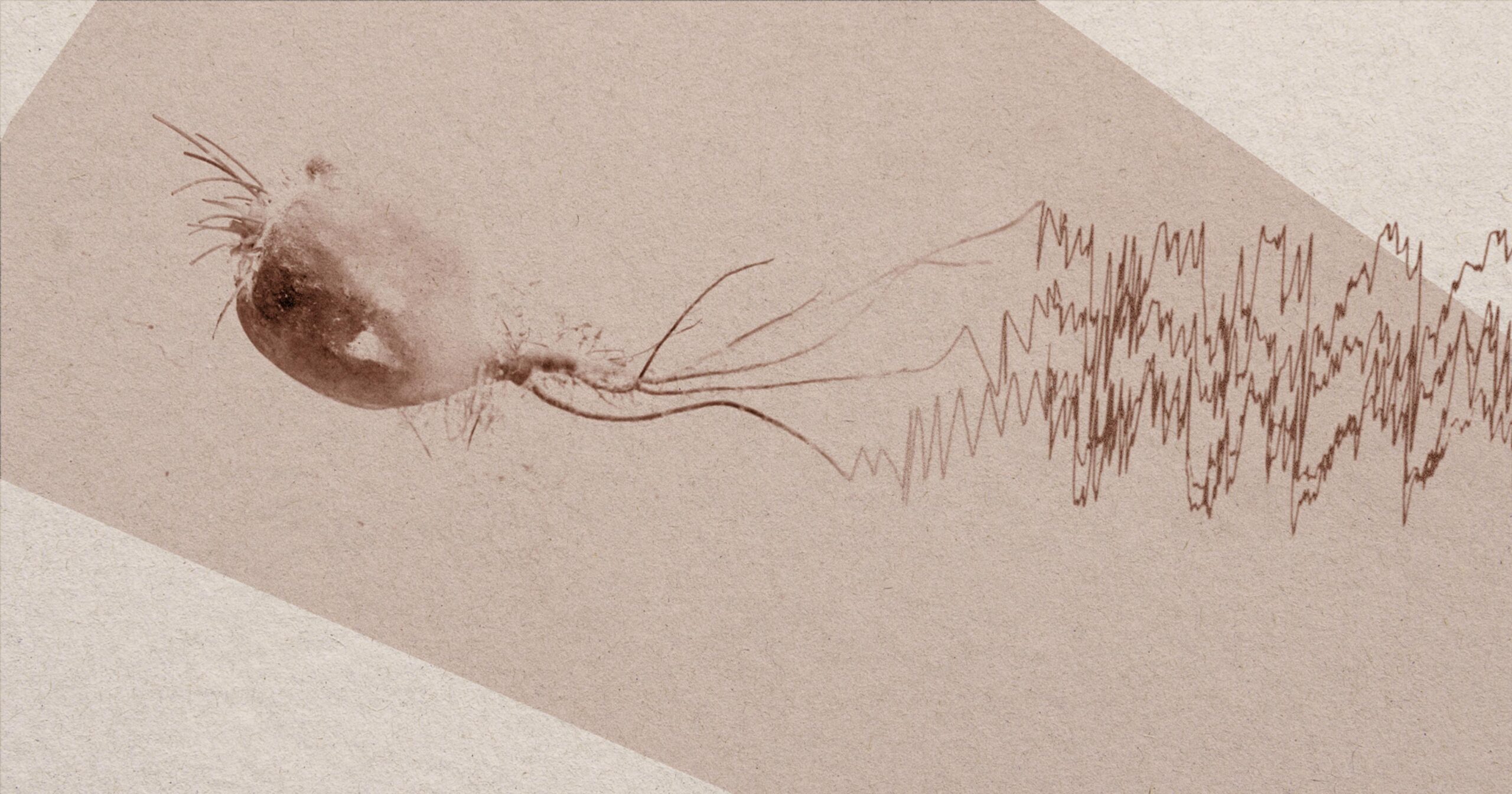

Graphic by Ali Aas
Researchers have long aimed to decode the language of plants. New technology is making tracking and translating that language possible.

In the summer of 1990, on the east side of the Sierra Nevada mountain range, Richard Karban, an entomologist at the University of California, Davis, could be found communing with wild tobacco and sagebrush.
Karban was here to study the natural defenses of wild tobacco, a close relative of the tomato plant, in an effort to decode the way plants analyze, predict, and respond to external threats. “Gaining an understanding of how plants do such a good job, so much better of a job than we are able to do, is ultimately going to [help us] protect our agricultural plants,” said Karban.
Today, technology is rising to translate these plant languages, and offer farmers a way to better predict and react to potential dangers. Vivent, a Swiss company working on translating bio-cues from plants, has developed sensor technology that captures and measures electrical signals plants give off under stress. Another company, Hortiya, based out of Germany, is using large language models (LLMs), the same technology that powers generative AI tools like ChatGPT, to decode plant behavior.
“What GPT does to text, we want to do to plant data,” said Marc Weimer-Hablitzel, Hortiya’s CEO.
The Sagebrush Speaks
The proximity of sagebrush in the wild tobacco field made Karban pause. He had recently read a study by Edward Farmer and Clarence Ryan, two early plant language pioneers. Their research showed that placing a cut sagebrush plant next to a tomato plant in a vacuum jar, sealed and left to incubate for two days, increased the tomato plant’s defenses against insects. “[The study found] we can damage one plant in a pot and observe an increase in resistance in another … without a root or physical connection between the two,” Karban said.
Farmer and Ryan speculated that a certain plant hormone, jasmonic acid, was being transferred by air from the sagebrush to the tomato, passing information and protective chemicals from one plant to another.
Karban was fascinated by this development and itching to test this theory outside of the lab. He began lopping the tops off the sagebrush plants, wafting their sweet, fresh aroma across the tobacco fields. He soon found the wild tobacco that neighbored the clipped sagebrush sustained less damage from local herbivores, which his research found was due to the volatile compounds released by trimmed sagebrush branches.
Karban would go on to study sagebrush for the next 30 years and become a global expert on plant language. Today, the study is a dense, rooted subject. We now know plants communicate in a number of ways: through electrical signaling above and below ground, by way of volatile organic compounds in the air, through common mycorrhizal networks, and even through sound.
Plant Wisdom for Farmers
A deeper understanding of the way plants speak, behave, and warn of danger, has the potential to transform modern farming methods and protect crops from damaging disease, infestation, and annihilation.
Carol Plummer, Vivent co-founder and CEO, said, “Plants have a lot of internal control mechanisms to help them adapt to the environment.” She continued, “They know if a fungal infection or a pest is attacking them, [and how to] mount a defense.”
Vivent’s technology is currently being piloted by a number of farms in Europe and North America. It’s already helped one Italian sugar beet farmer detect a root-based cutting worm days before the effects were visible on the plant leaves. Though, Plummer said, it didn’t save the crop, partly because the farmer was skeptical about the data they presented and didn’t heed the warning early enough.
In Canada, Vivent’s sensors also helped one farmer understand the benefit of a new misting system in his indoor greenhouse. “We could show him the crops inside the misting compartment were more resilient,” said Plummer. “He couldn’t see it with his eyes, but by the end of the crop cycle, the yields in the misting section were better. In the end, he invested more in the misting system because of that.”
Plummer said she is constantly amazed at the deep, intelligent communication between plants. “If you were an alien flying above the earth, looking for intelligent life, you would choose plants over people … they make up 80 percent of biomass on earth, have existed longer than us, and will exist far longer,” she said.

“If you were an alien flying above the earth, looking for intelligent life, you would choose plants over people.”

She noted that, in the past, much of our understanding of plant language has led to the development of pesticides that indiscriminately target plants, sick or healthy. She hopes that Vivent’s technology can reduce the need for preventative spraying, and move towards a more curative approach.
Hortiya uses sensor technology, much like Vivent, to observe and collect plant data in greenhouse settings. This data is then fed into the company’s “green brain,” or AI model, which then contextualizes and translates the findings into actionable steps for growers. “Machine learning and AI that we currently see are universal translators that can be applied to a variety of fields,” said Weimer-Hablitzel.
These kinds of AI models are crucial to understanding plant language at scale, said Paco Calvo, a professor of plant cognition at the Universidad de Murcia’s Minimal Intelligence Lab (MINT Lab) in Spain, due to the enormity of the datasets needed to accurately track and monitor plant behavior.
To truly anticipate stressors, behavioral changes, or disease, sensors must monitor plants 24/7, year-round. If humans were to analyze this data manually, it would take decades.
So far, Hortiya’s model has helped greenhouses better manage light control, heat, fertilizer, and watering. Weimer-Hablitzel said his ultimate goal is to aid food security and production, and to create better models for reducing the climate impact of agriculture.
Concerns remain about the environmental impact of generative AI models, often built of resource-heavy, carbon-saturated models. Weimer-Hablitzel claims Hortiya’s intelligent model will need less data as it grows, making onboarding new crops easier with each new iteration. He hopes his technology brings light to the capabilities of plants, as well as how far we are from understanding them in current practices. “We always assume plants are like machines, you have an input and predictable output,” he said. “But they are complex and highly adaptive organisms.”
Rethinking Nature’s Bounty
While technology has come a long way, some scientists are skeptical that a desire to exploit nature will bring humans the rewards we’re hoping for. “Plant systems are complicated,” said Karban. “And the expectation that there is going to be some simple switch that we can throw to ‘turn on’ defense or resistance, is kind of naive and unlikely to be possible.”
Karban explained that many of the problems modern plants face, especially those used for agriculture, are manmade. “There are ways of manipulating crop plants so that they function better in these weird agricultural environments, where we grow them under a set of conditions that they did not evolve to face,” he said. “But it’s not going to be a simple, silver bullet situation.”
In many cases, Karban said, closing one problem door may only open another. “If you take an aspirin because you have a headache, it might reduce your headache, but it has consequences in physiology. That is also true for plants.” A simple gene modification, or hormone introduced by air, can reduce a plant’s ability to produce beneficial bacteria, or it could promote resistance in target pests. Still, Karban admits, “I think over the long term, understanding how plants are doing this successfully will lead us to better solutions.”
For Calvo, unraveling the complex language of plants means deconstructing our preconceived notions of what plants are, and beginning to see them as subjects as well as objects. “Agriculture treats plants as resources to be exploited more or less, and if we continue to do that we will miss the plot.”
Not missing the plot means reevaluating our relationship with the wider, green universe. “It’s about giving careful thought to why we need technology for a certain purpose,” Calvo said. “Do I need this [plant] in my fridge? Just because we have the technology to grow it?”




